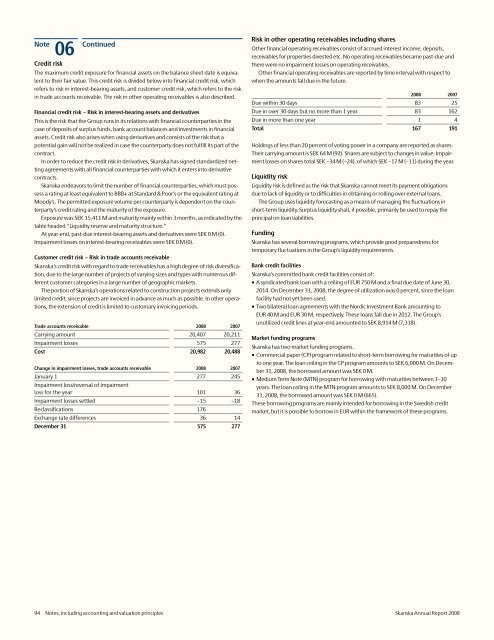Annual Report 2008 - Skanska
Annual Report 2008 - Skanska
Annual Report 2008 - Skanska
You also want an ePaper? Increase the reach of your titles
YUMPU automatically turns print PDFs into web optimized ePapers that Google loves.
Note<br />
06 Continued<br />
Credit risk<br />
The maximum credit exposure for financial assets on the balance sheet date is equivalent<br />
to their fair value. This credit risk is divided below into financial credit risk, which<br />
refers to risk in interest-bearing assets, and customer credit risk, which refers to the risk<br />
in trade accounts receivable. The risk in other operating receivables is also described.<br />
Financial credit risk − Risk in interest-bearing assets and derivatives<br />
This is the risk that the Group runs in its relations with financial counterparties in the<br />
case of deposits of surplus funds, bank account balances and investments in financial<br />
assets. Credit risk also arises when using derivatives and consists of the risk that a<br />
potential gain will not be realized in case the counterparty does not fulfill its part of the<br />
contract.<br />
In order to reduce the credit risk in derivatives, <strong>Skanska</strong> has signed standardized netting<br />
agreements with all financial counterparties with which it enters into derivative<br />
contracts.<br />
<strong>Skanska</strong> endeavors to limit the number of financial counterparties, which must possess<br />
a rating at least equivalent to BBB+ at Standard & Poor’s or the equivalent rating at<br />
Moody’s. The permitted exposure volume per counterparty is dependent on the counterparty’s<br />
credit rating and the maturity of the exposure.<br />
Exposure was SEK 15,411 M and maturity mainly within 3 months, as indicated by the<br />
table headed “Liquidity reserve and maturity structure.”<br />
At year-end, past-due interest-bearing assets and derivatives were SEK 0 M (0).<br />
Impairment losses on interest-bearing receivables were SEK 0 M (0).<br />
Customer credit risk − Risk in trade accounts receivable<br />
<strong>Skanska</strong>’s credit risk with regard to trade receivables has a high degree of risk diversification,<br />
due to the large number of projects of varying sizes and types with numerous different<br />
customer categories in a large number of geographic markets.<br />
The portion of <strong>Skanska</strong>’s operations related to construction projects extends only<br />
limited credit, since projects are invoiced in advance as much as possible. In other operations,<br />
the extension of credit is limited to customary invoicing periods.<br />
Trade accounts receivable <strong>2008</strong> 2007<br />
Carrying amount 20,407 20,211<br />
Impairment losses 575 277<br />
Cost 20,982 20,488<br />
Change in impairment losses, trade accounts receivable <strong>2008</strong> 2007<br />
January 1 277 245<br />
Impairment loss/reversal of impairment<br />
loss for the year 101 36<br />
Impairment losses settled –15 –18<br />
Reclassifications 176<br />
Exchange rate differences 36 14<br />
December 31 575 277<br />
Risk in other operating receivables including shares<br />
Other financial operating receivables consist of accrued interest income, deposits,<br />
receivables for properties divested etc. No operating receivables became past-due and<br />
there were no impairment losses on operating receivables.<br />
Other financial operating receivables are reported by time interval with respect to<br />
when the amounts fall due in the future.<br />
<strong>2008</strong> 2007<br />
Due within 30 days 83 25<br />
Due in over 30 days but no more than 1 year 83 162<br />
Due in more than one year 1 4<br />
Total 167 191<br />
Holdings of less than 20 percent of voting power in a company are reported as shares.<br />
Their carrying amount is SEK 64 M (92). Shares are subject to changes in value. Impairment<br />
losses on shares total SEK –34 M (–24), of which SEK –17 M (–11) during the year.<br />
Liquidity risk<br />
Liquidity risk is defined as the risk that <strong>Skanska</strong> cannot meet its payment obligations<br />
due to lack of liquidity or to difficulties in obtaining or rolling over external loans.<br />
The Group uses liquidity forecasting as a means of managing the fluctuations in<br />
short-term liquidity. Surplus liquidity shall, if possible, primarily be used to repay the<br />
principal on loan liabilities.<br />
Funding<br />
<strong>Skanska</strong> has several borrowing programs, which provide good preparedness for<br />
temporary fluctuations in the Group’s liquidity requirements.<br />
Bank credit facilities<br />
<strong>Skanska</strong>’s committed bank credit facilities consist of:<br />
• A syndicated bank loan with a ceiling of EUR 750 M and a final due date of June 30,<br />
2014. On December 31, <strong>2008</strong>, the degree of utilization was 0 percent, since the loan<br />
facility had not yet been used.<br />
• Two bilateral loan agreements with the Nordic Investment Bank amounting to<br />
EUR 40 M and EUR 30 M, respectively. These loans fall due in 2012. The Group’s<br />
unutilized credit lines at year-end amounted to SEK 8,914 M (7,318).<br />
Market funding programs<br />
<strong>Skanska</strong> has two market funding programs.<br />
• Commercial paper (CP) program related to short-term borrowing for maturities of up<br />
to one year. The loan ceiling in the CP program amounts to SEK 6,000 M. On December<br />
31, <strong>2008</strong>, the borrowed amount was SEK 0 M.<br />
• Medium Term Note (MTN) program for borrowing with maturities between 1–10<br />
years. The loan ceiling in the MTN program amounts to SEK 8,000 M. On December<br />
31, <strong>2008</strong>, the borrowed amount was SEK 0 M (665).<br />
These borrowing programs are mainly intended for borrowing in the Swedish credit<br />
market, but it is possible to borrow in EUR within the framework of these programs.<br />
94 Notes, including accounting and valuation principles <strong>Skanska</strong> <strong>Annual</strong> <strong>Report</strong> <strong>2008</strong>

















